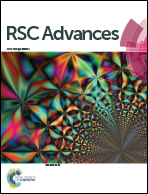Electronic and optical properties of [Au(CH3CSS)]4 cluster. A quantum chemistry study†
Abstract
The uses of the sulfur–gold bond in the design of new molecular clusters have gained increasing attention in recent years. Their size and shape are diverse providing a wide variety of optical and electronic properties. Here we present a computational study of the absorption and emission properties of a small [Au(dithioacetate)]4 cluster as a model for these systems. The electronic structure of the Au4S8 core of this cluster permits rationalization of the source of the optical properties and how these are connected with that specific structural scaffold. Due to the complex nature of the aurophilic intramolecular interactions taking place in this system, several methods were used, such as the MP2, SCS-MP2, PBE-D3, and TPSS-D3 levels; both in gas and solvent phases. The absorption spectra of the cluster were calculated by the single excitation time-dependent-DFT (TD-DFT) method, CC2, SCS-CC2, and ADC(2) levels. The ab initio correlated calculations and previously reported experimental data have been used to assess the performance of our calculations. Moreover, the emission T1–So transition was calculated, where the SCS-CC2 level showed an excellent agreement with the experimental results. The core Au4S8 was identified as mainly responsible for the absorption and emission transitions according to the theoretical model.
![Graphical abstract: Electronic and optical properties of [Au(CH3CSS)]4 cluster. A quantum chemistry study](/en/Image/Get?imageInfo.ImageType=GA&imageInfo.ImageIdentifier.ManuscriptID=D0RA06982E&imageInfo.ImageIdentifier.Year=2020)


 Please wait while we load your content...
Please wait while we load your content...